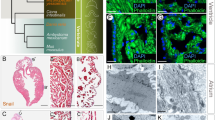Abstract
The gap junction protein connexin43 (Cx43) is widely expressed in all vertebrate species; however, in ventricular myocardium, Cx43 expression is restricted to mammalian species only, where it provides the molecular correlate for both electrical conduction and synchronization of the repolarization process. The evolutionarily “late” appearance of Cx43 in the heart suggests physiological adaptation to euthermia with its concomitant demands related to increased cardiovascular output. We tested to what extent mammalian Cx43 differs from that of non-mammalian vertebrates and whether Cx43 from hibernating species contains specific sequence characteristics which could be attributed to their non-isothermal life cycle. We cloned the complete coding region of Cx43 from the African green monkey, European hedgehog (hibernator), Russian dwarf hamster, rabbit, European ground squirrel (hibernator) and pig. After sequencing, these were compared to 12 full-length Cx43 sequences present in GenBank (3 fish, 2 frogs, chicken and 6 mammals amongst which there was one other hibernator). Overall identity ranged from 68.7% to 97.7% at the nucleotide level and from 71.6% to 99.7% at the amino acid level. The phylogeny of Cx43 mirrors the general phylogenetic histories of the investigated species to a large extent. From 382 amino acids there were only 6 specific for mammals. There were no substitutions specific for hibernators. In conclusion, mammalian Cx43 is characterized by 6 specific amino acids, and no obvious differences between non-hibernating and hibernating mammals were observed.



Similar content being viewed by others
References
Becker DL, Cook JE, Davies CS, Evans WH, Gourdie RG (1998) Expression of major gap junction connexin types in the working myocardium of eight chordates. Cell Biol Intl 22:527–543
Beyer EC, Kistler J, Paul DL, Goodenough DA (1989) Antisera directed against connexin43 peptides react with 43-kDa protein localized to gap junctions in myocardium and other tissues. J Cell Biol 108:595–605
Dahl G, Werner R, Levine E, Rabadan-Diehl C (1992) Mutational analysis of gap junction formation. Biophys J 62:172–180
Duffy HS, Sorgen PL, Girvin ME, O’Donnell P, Coombs W, Taffet SM, Delmar, Spray DC (2002) pH-dependent intramolecular binding and structure involving Cx43 cytoplasmic domains. J Biol Chem 39:36706–36714
Ek JF, Delmar M, Perzova R, Taffet SM (1994) Role of histidine 95 in pH gating of the cardiac gap junction protein connexin 43. Circ Res 74:1058–1064
Giepmans BNG (2004) Gap junctions and connexin-interacting proteins. Cardiovasc Res. DOI 10.1016/j.cardiores.2003.12.009
Goodenough DA, Paul DL (2003) Beyond the gap: functions of unpaired connexon channels. Nat Rev Mol Cell Biol 4:285–294
Griswold CK, Whitlock MC (2003) The genetics of adaptation: the roles of pleiotropy, stabilizing selection and drift in shaping the distribution of bidirectional fixed mutational effects. Genetics 165:2181–2192
Heyden MAG van der, Roeleveld L, Peterson J, Destrée OHJ (2001) Connexin43 expression during Xenopus development. Mech Dev 108:217–220
Higgins DG, Sharp PM (1990) Fast and sensitive multiple sequence alignments on a microcomputer. Comput Appl Biosci 5:151–153
Johansson BW (1967) Heart and circulation in hibernators. In: Fisher KC, Dawe AR, Lyman CP, Schönbaum E, South FE (eds) Mammalian hibernation III. Oliver and Boyd, Edinburgh, pp 199–218
Kanemitsu MY, Lau AF (1993) Epidermal growth factor stimulates the disruption of gap-junctional communication and connexin43 phosphorylation independent of 12-O-tetradecanoylphorbol 13-acetate-sensitive protein kinase C: the possible involvement of mitogen-activated protein kinase. Mol Biol Cell 4:837–848
Lampe PD, TenBroek EM, Burt JM, Kurata WE, Johnson RG, Lau AF (2000) Phosphorylation of connexin43 on serine368 by protein kinase C regulates gap junctional communication. J Cell Biol 149:1503–1512
Morley GE, Ek-Vitorín JF, Taffet SM, Delmar M (1997) Structure of connexin43 and its regulation by pHi. J Cardiovasc Electrophysiol 8:939–951
Musil LS, Beyer EC, Goodenough DA (1990) Expression of the gap junction protein connexin43 in embryonic chick lens: molecular cloning, ultrastructural localization, and post-translational phosphorylation. J Membr Biol 116:163–175
Paznekas WA, Boyadjiev SA, Shapiro RE, Daniels O, Wollnik B, Keegan CE, Innis JW, Dinulos MB, Christian C, Hannibal MC, Jabs EW (2003) Connexin43 (GJA1) mutations cause the pleiotropic phenotype of oculodentodigital dysplasia. Am J Hum Genet 72:408–418
Phelan P, Starich TA (2001) Innexins get into the gap. BioEssays 23:388–396
Revilla A, Bennett MV, Barrio LC (2000) Molecular determinants of membrane potential dependence in vertebrate gap junction channels. Proc Natl Acad Sci USA 97:14760–14765
Sáez JC, Nairn AC, Czernik AJ, Fishman GI, Spray DC, Hertzberg EL (1997) Phosphorylation of connexin43 and the regulation of neonatal rat cardiac myocyte gap junctions. J Mol Cell Cardiol 29:2131–2145
Saitou N, Nei M (1987) The neighbor-joining method: a new method for reconstructing phylogenetic trees. Mol Biol Evol 4:406–425
Söhl G, Willecke K (2003) An update on connexin genes and their nomenclature in mouse and man. Cell Commun Adhes 10:173–180
Swenson KI, Piwnica-Worms H, McNamee H, Paul DL (1990) Tyrosine phosphorylation of the gap junction protein connexin43 is required for the pp60v-src-induced inhibition of communication. Cell Regul 1:989–1002
Willecke K, Eiberger J, Degen J, Eckardt D, Romualdi A, Guldenagel M, Deutsch U, Söhl G (2002) Structural and functional diversity of connexin genes in the mouse and human genome. Biol Chem 383:725–737
Acknowledgements
We thank Dr. R.H. Henning and Dr. L.E. Deelman (Groningen University, the Netherlands), Dr. J. Seddon (Uppsala University, Sweden) and Dr. G. Hewitt (University of East Anglia, United Kingdom), M.C.J. Mutsaers (Super de Boer, Princehage), and P. Vrolijk (Hamstery Vrolijk, Nieuwegein) for providing tissue samples from ground squirrel, hedgehog, pig and Russian dwarf hamster, respectively. This study was supported by STW grant MKG.5942 (MvdH).
Author information
Authors and Affiliations
Corresponding author
Additional information
Edited by D. Tautz
Rights and permissions
About this article
Cite this article
van der Heyden, M.A.G., van Eijk, M., Wilders, R. et al. Connexin43 orthologues in vertebrates: phylogeny from fish to man. Dev Genes Evol 214, 261–266 (2004). https://doi.org/10.1007/s00427-004-0403-7
Received:
Accepted:
Published:
Issue Date:
DOI: https://doi.org/10.1007/s00427-004-0403-7




